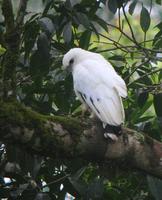ERROR : Server Busy(-1105)
ERROR : Server Busy(-1105)
White Hawk - Iain Campbell
Tropical Birding tour report: The Yucutan and Palenque
We’d
planned an early morning at Palenque today, but the rain kept up all
night and
into the morning???a
norte
was upon us,
a fairly rare event this far south. We waited out the downpour and
eventually
made it to Palenque to bird in the lighter rain. A Bat Falcon greeted
us right
away. He continued to entertain us throughout our time here, alighting
atop
various temples between hunting forays. Great Kiskadees and Boat-billed
and
Social Flycatchers perched conspicuously in the tops of dead trees and
gave us
some nice studies as we discussed the ID of these three similar
species. Flocks
of Neotropical migrants yielded Wilson’s Warbler, Summer
Tanager, and Orchard
and Baltimore Orioles. A Stripe-throated Hermit attracted our attention
alongside the edge of the ruin grounds, where we also found Great
Antshrike,
Yellow-bellied Flycatcher, Thrush-like Schiffornis, White-breasted
Wood-Wren,
Clay-colored Robin, and Olive-backed Euphonia. A nice Violaceous Trogon
was
perched on a power line as we left the site.
6 Feb:
Today
was fast-paced. We changed our minds and decided to end the tour with a
trip to
Cozumel, so we had to take in both Bonampak and Yaxchil??n in
one day. We pulled
it off nicely, but both of these incredible areas really do deserve
more time
than this.
Just
after dawn, we were
birding the entrance road into Bonampak, which was incredibly birdy.
Though
Mexico’s avian diversity is amazing, it is here that you
really feel like
you’re in the tropics, as most birds and indeed bird families
you see are
completely alien to North American eyes. A spectacular male
Chestnut-colored
Woodpecker perched on a dead snag offered incredible
views???one of my favorite
moments of the tour. A White-whiskered Puffbird perched on a power
line, while
a male White-collared Manakin flew back and forth across the road,
displaying
to a female. Montezuma Oropendolas sang their bizarre song from the
tops of
tall trees while Scaly-throated Leaftossers and Mexican Antthrushes
seemingly
answered from the forest floor. Birds in the undergrowth included
Orange-billed
Sparrow, Gray-headed Tanager, Thrush-like Schiffornis, and the
ridiculous-looking Long-billed Gnatwren. The mixed flocks here were
amazing,
featuring Tropical Gnatcatcher, Tawny-crowned Greenlet, Green
Shrike-Vireo,
Sulphur-rumped Flycatcher, Stub-tailed Spadebill, Dusky Antbird,
Dot-winged
Antwren, Barred Antshrike, Plain Xenops and a host of woodcreepers:
Strong-billed, Streak-headed, Wedge-billed, and Olivaceous. During the
walk
back from the ruins we heard some very loud bell-like notes from inside
the
rainforest???a Rufous Piha! Eventually we found him and watched
him sing for a
few incredibly loud minutes. A Double-toothed Kite flew over the
road. |

